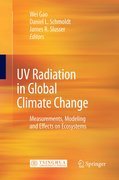
UV radiation in global climate change: measurements, modeling and effects on ecosystems
Gao, Wei
Schmoldt, Daniel L.
Slusser, James R.
Numerous studies report that ultraviolet (UV) radiation is harmful to living organisms and detrimental to human health. Growing concerns regarding the increased levels of UV-B radiation that reach the earth's surface have led to the development of ground- and space-based measurement programs. Further study is needed on the measurement, modeling, and effects of UV radiation. The chaptersof this book describe the research conducted across the globe over the past three decades in the areas of: (1) current and predicted levels of UV radiationand its associated impact on ecosystems and human health, as well as economicand social implications; (2) new developments in UV instrumentation, advancesin calibration (ground- and satellite-based), measurement methods, modeling efforts, and their applications; and (3) the effects of global climate change on UV radiation. Dr. Wei Gao is a Senior Research Scientist and the Director ofthe USDA UV-B Monitoring and Research Program, Natural Resource Ecology Laboratory, Colorado State University. Dr. Gao is a SPIE fellow and serves as the Editor-in-Chief for the Journal of Applied Remote Sensing. Dr. Daniel L. Schmoldt is the National Program Leader for instrumentation and sensors at the National Institute of Food and Agriculture (NIFA) of the U.S. Department of Agriculture. Dr. Schmoldt served as joint Editor-in-Chief of the journal, Computers & Electronics in Agriculture, from 1997 to 2004. Dr. James R. Slusser retired in 2007 from the USDA UV-B Monitoring and Research Program at Colorado State University. He was active in the Society of Photo-Optical Instrumentation Engineers, the American Geophysical Union, and the American Meteorological Society. Dr. Slusser is currently pursuing his interests in solar energy and atmospheric transmission. " Includes the latest developments in UV research as well as the interactions between UV radiation and global change, environment and ecosystems Contributing authors are renowned scientists in the research fields of UV radiation, meteorology, environment, and ecosystems INDICE: Preface.- Introduction.- Chapter 1. Overview of UV radiation, and its effects.- .- Chapter 2. UV radiation instrumentations, measurements and calibrations.- Chapter 3. Modeling of UV in atmosphere and ocean.- Chapter 4. Long term UV time series.- Chapter 5. Instrumentations advances and UV measurement.- Chapter 6. Global Retrievals of UV irradiance and other products from satellite.- Chapter 7. Mesoscale distributions of ultraviolet spectral irradiance, actinic flux, and photolysis rates derived from multispectral satellite dataand radiative transfer models.- Chapter 8. Air pollution: tropospheric ozone,aerosol and UVB radiation.- Chapter 9. Aerosol and trace gases effecting UV transmittance through atmosphere.- Chapter 10. Trends and interannual variability in surface UV-B radiation over 8-11 years observed across the United States.- Chapter 11. Comparison of measured and modeled spectral ultraviolet irradiance at Antarctic stations used to determine biases in total ozone data from various sources and a long tern UV time series in Polar region.- Chapter 12. Themeasurement and modeling of broadband UV-A irradiance.- Chapter 13. Derived direct irradiance from High Resolution UV Spectroradiometer Uses: Langley regression radiometric calibration, ozone column and aerosol retrievals.- Chapter 14. The Spatial and temporal variability analysis of Erythemal Exposure with TOMS data in U.S.A..- Chapter 15. Solar UVA exposures.- Chapter 16. UV-B Effect on Ecosystems and simulations of different UV radiation level.- Chapter 17. Health impacts of ultraviolet radiation in urban ecosystems: a review.- Chapter 18. Modeling Ultraviolet-B radiation in ecosystems.- Chapter 19. Genotypic variation of soybean and cotton crops in their response to UV-B radiation for vegetative growth and physiology.- Chapter 20. Vitamin D. Optimal dosages of UVB:how much is enough, too much.- Chapter 21. UV-B tolerance characteristics of selected southern broadleaf trees in USA.- Chapter 22. Coupling Short-term Changes in Ambient UV-B levels with induction of UV-screening Compounds.
- ISBN: 978-3-642-03312-4
- Editorial: Springer
- Encuadernacion: Cartoné
- Páginas: 550
- Fecha Publicación: 15/10/2009
- Nº Volúmenes: 1
- Idioma: Inglés
